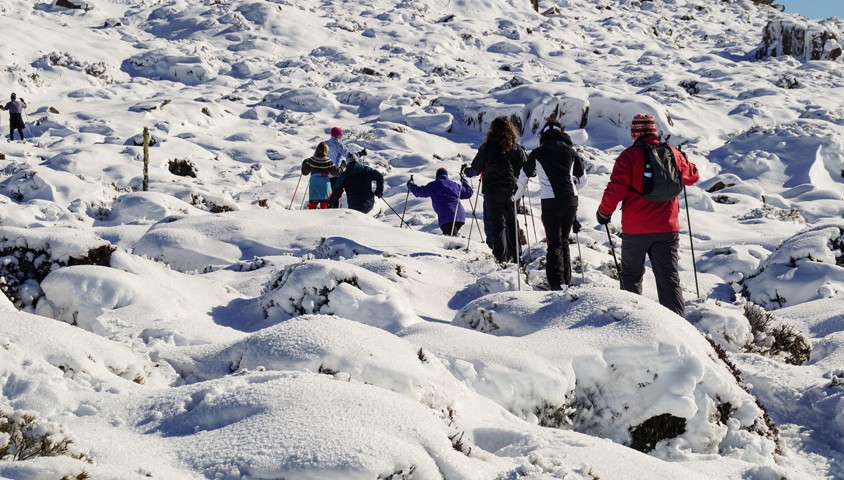By the end of the century, skiing and winter as we know them will have altered irrevocably.
Internationally, climate concerned ski resorts are investing heavily in snow-making technology and renewable energy. Educational campaigns emphasising the impact climate change will have on alpine areas and snowfall are also becoming a standard part of ski resorts, because the impact will be severe. Already in the last 50 years, the northern hemisphere has lost more than 2.5 million square kilometres of spring snow cover, the snowfall most affected by rising temperatures. Climatologists examining the future of the Winter Olympics in light of cancellations at Sochi estimated that of the 19 cities that have previously hosted the winter games, only 10 might be able to do so again by mid-century, and by 2100 only six will still be reliably cold enough.
Here in Australia, The Impact of Climate Change on Snow Conditions in Mainland Australia, a 2003 report by the Commonwealth Scientific and Industrial Research Organisation (CSIRO), found that the Snowy Mountains had lost a third of its snowpack since the 1950s. It also reported that the mountains could lose more than half their snow again by mid-century. The 2013 update to the Victorian-specific aspects of the report, with a decade of further climate science behind it, noted that the emissions scenario over those years had been following the medium to high emissions projections. The updated report continued to estimate decreases in snow cover, snow depth and snow-season length. Since 2007, Perisher alone has invested more than $22 million in snowmaking infrastructure.
Of course, investment in snowmaking technology only limits the effects of early climate change symptoms; for the dramatic changes to emissions necessary, energy production and consumption need to be radically rethought, and Australia’s commitment to cut emissions is minimal. Undoubtedly aware of this, United States ski giant Vail Resorts bought Perisher for A$178 million in March this year. While the resort itself shudders under the weight of a warming climate, the hope for Vail is that Australian skiers will continue investing in season passes with the guarantee of at least being able to ski in North America if the Australian season is negligible. Ironically, in order to escape the effects of climate change, people are being encouraged to seasonally fly half-way around the world and back. Even more recently, in May, Thredbo joined the Mountain Collective as the first fully international partner of an otherwise North American focused collective of independent ski resorts.
Yet, as bad as the situation looks for the mainland Australian resorts, perhaps these businesses can take some inspiration from the most unlikely of sources: Ben Lomond, Tasmania. Not because climate change will be kind to this ski slope (quite the reverse), but because this surprisingly popular resort with its loyal following has always struggled with difficult conditions.
This is not to say that conditions were poor when I visited Ben Lomond for the first time. I had booked flights to Tasmania months earlier for an early July trip with my partner Nick, and we had entirely resigned ourselves to the likelihood of a snowless visit. On my part, I was happy enough to be visiting Ben Lomond at all, and particularly keen on the prospect of staying with Nick’s family at one of the ski lodges. With the ski village sitting at a mere 1,470 metres above sea level, and the highest peak of the mountain, Legges Tor, at 1,572 metres, luck and short-term weather conditions play almost as much a part as the season, with snow falling in summer some years and barely falling in winter in others. In our case, an early dump of snow meant a magical week on the plateau, almost entirely missed by the ski tow operators who opened the lifts a week after the fall.
These surprising dumps of snow, contrasted against inevitable disappointment when expecting snow, were established as a norm early in the history of northern Tasmanian skiing. In fact, northern Tasmanian skiing was first inspired by an enormous dump in 1929, which generated so much enthusiasm and so many home-made skis (early ones modelled on those left behind by Amundsen on his return from the South Pole) that the Northern Tasmanian Alpine Club (NTAC) was formed by the end of the year. Frederick Smithies, a driving force and founder of this club, was also the one to look to Ben Lomond when the bitter disappointment of the very next season proved that Pine Lake on the Western Tiers, at around 1,200 metres above sea level, was not going to get reliably skiable snow…
…The story continues in Wild issue 148, available now. Subscribe today.



